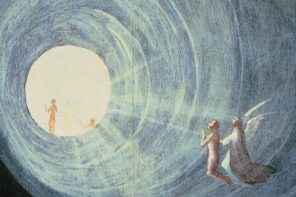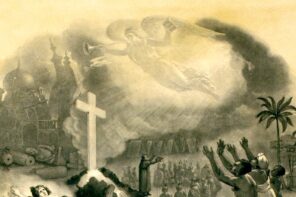There is something tempting about the casual, and sometimes not-so-casual, reflexivity of this time of year. Even if it is indebted just a bit too much to the artifice of a very old Roman calendar, and the curious modern pretense of a new year’s “beginning” in the depths of winter, just after the vernal solstice tilts the northern hemisphere of our stop-start planet back in favor of warmer weather and the promise of an eventual springtime. I will return to that potent image, of a warming planet tilting its northern pole sunward, at the end of this reflection.
There may even be something natural-seeming, to us, in this ritual taking stock—of ourselves, and our world—in such a season, and the attraction to the ritual increases when the calendar tells us that the new year beginning will ring in a new decade, or century, or what have you.
Since I try to introduce an historical perspective in most of my classes, I find myself speaking of decades, and centuries, and millennia, almost as a matter of natural course. And for some reason, I have found it very difficult to stop speaking as if we lived still in the twentieth century. Describing the passage of time in one’s own lifetime a decade at a time requires some creativity and thoughtfulness; marking the appearance of a new decade, or a new century, proves to be far more challenging than remembering to change the year on the checks and Thank You notes I write in January.
This time around, there’s no escaping the fact that our collective feet are now planted firmly in the twenty-first century. And it is worth reflecting on what this dawning perspective (of seeing ourselves as twenty-first century people) implies for the way we think about, and talk about, religion today… as a not-so-new century readies the celebrations for its ten-year-old birthday.
Religion is back…again
The tempting place to begin is with what has almost become a twenty-first century truism: that in this new century, religion was decidedly “back.” Just one year into this new century, religion of a certain sort literally exploded across the brainscape of a wondering and worried world. The September 11 attacks put religion on a front burner everywhere: on television and internet discussions, and even at state universities, where suddenly legislatures did not need to be convinced of the importance of knowing something about other religious traditions from around the world.
But there is something falsifying about this crude historical truism, the one claiming that religion enjoyed a tortured comeback of sorts in the year 2001. If anything, religion had already been “back” for a generation, by then. The really singular date for any contemporary discussion of the resurgence of politicized neo-traditional religion is 1979, not 2001.
It was in 1979 that the Ayatollah Khomeini’s revolutionary movement seized power in Iran.
It was in 1979 that Jerry Falwell formed the Moral Majority in the United States and began lobbying hard, not just for a fundamentalist return to the political arena, but for the neo-conservative agenda of then–candidate Ronald Reagan.
It was in 1979 that John Paul I died unexpectedly after a very brief pontificate, resulting in the equally unexpected elevation of John Paul II to the papacy, the first non-Italian pope to be so elevated since the middle of sixteenth century. John Paul II quickly established himself, again somewhat surprisingly, as a man of unusual charismatic and media talents, but also as a pope with some jarring and nearly reactionary theological attitudes.
It is worth reflecting on the symbolic significance of the fact that all three of these men have since passed on, and that the movements they left behind are currently trying to re-think what they should become one generation later. The times they are a changin’. It was not long before scholars of religion—most notably Bruce Lawrence (in Defenders of God), and Mark Juergensmeyer (in The New Cold War?), both writing in the early 1980s—began theorizing about the emergence of this new, and global, religious phenomenon as an explicitly anti-modern form of religious nationalism and/or religious identity.
If the old-style secularization story (that religion inevitably goes away in the face of Western-style modernity) could not be maintained in the face of these global movements, and if a certain sort of religion seemed to be so indubitably and dramatically “back” in 1979, then the question of what these trends meant for the future could no longer be avoided. Juergensmeyer demonstrated the ways in which such movements offered a coherent and attractive alternative to the reigning paradigms of ethnic or civic nationalism; religious nationalism, in his view, long a staple of resistance against various forms of imperialism, had finally come of age. Lawrence worked comparatively to show how such movements possessed and expressed some surprising similarities across the boundaries of traditional religious confession; fundamentalism was, in his view, a legitimate comparative category that helped name what he viewed as a religious “revolt against the modern age.”
A decade of confusion
I will return to the question of modernity and the various reactions it has spawned, but here I want to notice the way in which each of the movements he seemed to involve a religious reaction against a certain 1960s-style form of the counterculture.
The Protestant case in the United States is especially instructive here. Whereas self-styled “fundamentalists” in 1920 identified themselves as opposed to Darwinian science and Liberal Protestant theology, in the 1970s their target had shifted decisively: feminism, sexual liberation, and secular politics were the new theological and cultural targets du jour. John Paul II’s resolve in undoing a great deal of the Second Vatican Council’s “new openness to the modern world” (another product of the mid-1960s) may be read in similar terms, as may Khomeini’s reaction against many Iranian clerics’ proximity to, and collusion with, the secular reforms of Western-leaning and Western-style political leaders like the Shah. We live in that world still today, and it is in this sense that we did not need the September 11 attacks to learn that a certain form of neotraditional religiosity was alive and well around the world.
What happened in the new century, and what has taken up a great deal of our cultural attention in the past decade, is that certain forms of neo-traditional religion became increasingly violent, very fast. This resurgent religious violence has prompted an aggressive, and often violent, secularist push-back as a form of modernist reaction against religious anti-modernism. It is a pendulum swing I am trying to trace here, and my sense is that it has been swinging for a generation, if not longer.
What is striking, and at least arguably fairly new, is how confused we seem to be these days—about religion, about the secular sphere, and about the future of both as embodying forms of political commitment capable of peaceable coexistence.
Religious Studies gone public
Religion Dispatches, itself a product of this same confused decade, is intended to provide one such place, in which ethically serious and politically engaged persons from a variety of religious and political confessions can reflect on the possibilities of such religious rapprochement.
RD’s own Katie Lofton has observed, with her singular acerbic wit, that Religion Dispatches represents a movement she describes as “Religious Studies gone public”; there is something of great substance, and great moment, in that astute observation.
As William E. Connelly observes in his important new book, Capitalism and Christianity, American Style, one of the most striking features of a contemporary Religious Studies department is its easy acceptance of permanent pluralism as the necessary starting point for religious reflection. It’s easy to miss how new, how important, and how startling that starting point really is. Gone are the days when even conservative Christians dream of the eventual “conversion of the Jews” (I leave Benedict XVI’s perplexing and repeated anti-Jewish missteps to one side for now). The point is that religious persons of various persuasions now almost casually accept religious pluralism as a fact of modern life that will not go away. Many neo-traditional religious persons may still dream of some individual evangelical successes, but the whole orientation of religion worldwide has shifted in the face of the growing awareness of the necessity of confronting pluralism as a permanent state of cultural affairs. When current religious forms turn violent, whom and what they attack are precisely those religious “others” whom they have no real hope or expectation of converting. So they attack and kill instead.
One decade into the twenty-first century, then, religion is quite literally everywhere. It is not all Christian, it is not all monotheistic, and it is not even necessarily theistic at all. As scholars of religion have ventured, if we turn the kaleidoscope on our perceptions of “religion,” and replace the with the rhetoric of sacrality, then we will notice a great deal of rather clearly religious activity that is not located in traditionally “religious” venues at all—venues housing cultural matters like sport, and music, and film.
What seems to me to require further critical reflection in the wake of a year’s ending and a new decade’s imminent arrival, are some especially salient contemporary problems. Some of these are older than others, but they are all decidedly modern: the crisis in global capital (which still seems to me the singular crisis of the past decade); and the uninspiring forms of industrial warfare still alive and none-too-well in Iraq and Afghanistan.
There are also some new trends worth tracking, and Religion Dispatches was formed in large measure to enable better reflection upon them. The first has to do with the continued advances in contemporary communications technologies. RD serves a population that will continue to receive more and more of its news and information online (this trend will continue apace, as newspapers continue to shrink and/or disappear). If the religious reactions of 1979 were aimed against student-led activism of the 1960s, then it will be very interesting to see what forms religious reaction will take to the student protests in places like Tehran, or Athens, or Beijing, that are armed and enabled by cell phone technology and the almost instantaneous circulation of striking images of authoritarian crackdown, impossible to contain or control.
There is an old philosophical quandary posed as follows: can a fish imagine water? Similarly, Religion Dispatches exists within the very medium that it is simultaneously attempting to theorize. It is as global as the instruments it uses, and as intimately pervasive as the religious and cultural phenomena it attempts to describe.
When the last of the earth’s coal has been burned…
But something new is brewing, and it will require thoughtfulness and great care in the months and years ahead. This is an issue that both blends and exploits the twinned matters of modern technology and an interconnected, energy-driven global economy. These are symbols of the very modernity I have already mentioned as inspiring various forms of religious reaction around the world.
There will be no global matter impressing its importance upon all of us in the next decade than the pending environmental crisis now looming on the horizon of our common hopes and fears. Global warming and rising sea levels will impact every human being on the planet, and will place unique new pressures of interpretation and understanding on each and every religious tradition—whether new, or old, or just emerging.
Perhaps the most striking thing about the disappointments expressed at and after the Copenhagen conference is not how little of substance was accomplished there. Not at all. The various degrees of dawdling, foot-dragging and political maneuvering were striking but hardly shocking; the level of complete and utter self-deception evident in Copenhagen was. Politicians are still talking with a straight face about the need to move quickly “to undo and to reverse” current climate trends.
No one seems willing or able to state the obvious: that this train has already left the station.
If one listens closely to most environmental scientists (their notorious email chatter aside for now), they are expressing shock at how exponential the current losses of polar ice actually are. There may well be no ice on the northern pole when the time comes for someone to reflect on this site about religion’s future in 2020. A decade can be a very long time, and some things can move and change very rapidly indeed. Global warming is such a thing.
Max Weber famously observed that capitalism’s real crisis would come when the last bit of the earth’s coal had been burned. What contemporary environmental scientists have reminded and urged upon us is the way in which the entire planet comprises a single system, and that from the perspective of this material one-world-ism, the swift and shocking transfer of so much carbon-based material from under the earth into the sky in little more than one century has changed and will continue to change the entire global system in some very catastrophic ways.
The apocalyptically-minded have the resources to read these trends one way. The sudden popular anxiety over the Mayan predictions of cataclysm in 2012 speaks among other things to the pervasive cultural appetite for such apocalyptic visions these days.
But the temptations of a facile apocalypticism are important to resist. In the waning light of reality, in late 2009, we face several crises of global reach and tragic, universal impact. There is an adjustment of staggering proportions still in the offing within the system of global capital. The range of global military actions unleashed by the 9/11 attacks dramatically demonstrate the way that modern wars do not respect national borders, nor traditional regulations concerning individual rights and non-combatant immunity. There is a seismic and revolutionary potential yet to be fully exploited in the new global communications technologies. And this world, our one and only, is currently in the midst of dramatic changes that are staggering in their suddenness and frightening in their potential for transforming the very habitability of this, our only home.
If religion has anything to do with being at home in the universe, then religions today can and should have much to say about each and every one of these new, and truly global crises. To say something meaningful, and to say it well, will require the art of imagination that religious energies have traditionally been marshaled to inspire. It is for this reason that I hope to devote further energy and attention to the marvelous and complex overlap between religion and art in the new year.
But between now and then, there will be much food and drink, parties to attend, football games and concerts and films to watch. May it be so for all of you, too.




